Worried about swelling around your horse’s throatlatch behind their cheek? This could be “Horse Grass Glands.”
Although it’s great to be alert, it’s also important to take the bigger picture into account.
Check over your horse for symptoms such as increased temperature, nasal discharge, and the feeling of swelling. A fever and nasal discharge are not symptoms of Grass Glands and may indicate something more serious.
If possible, ask the barn management if anyone noticed any swelling prior to your horse being turned out on grass (a great barn team can help answer many of your questions).
Grass Glands are a relatively harmless condition that subsides on its own. Although veterinarian confirmation of the condition is great to have because there are other problems that are related to swollen glands and Lymph Nodes. However, it is often not needed if your horse is not showing any other signs of feeling unwell.
As for myself, if I am ever unsure, doubtful, or worried about a horse’s condition, I simply call the vet and get their opinion over the phone, just to have peace of mind.
The vet will usually tell me whether they should come out to check the horse, what I should keep an eye out for, and/or what I can do to help my horse if there is anything that should be done.
In this article, I am going to explain exactly what Horse Grass Glands are and how they are different from other types of lumps that may appear in horses.
I’ll also answer other commonly asked questions you may have related to Grass Glands, grass and horses, and swellings around the horse’s head.
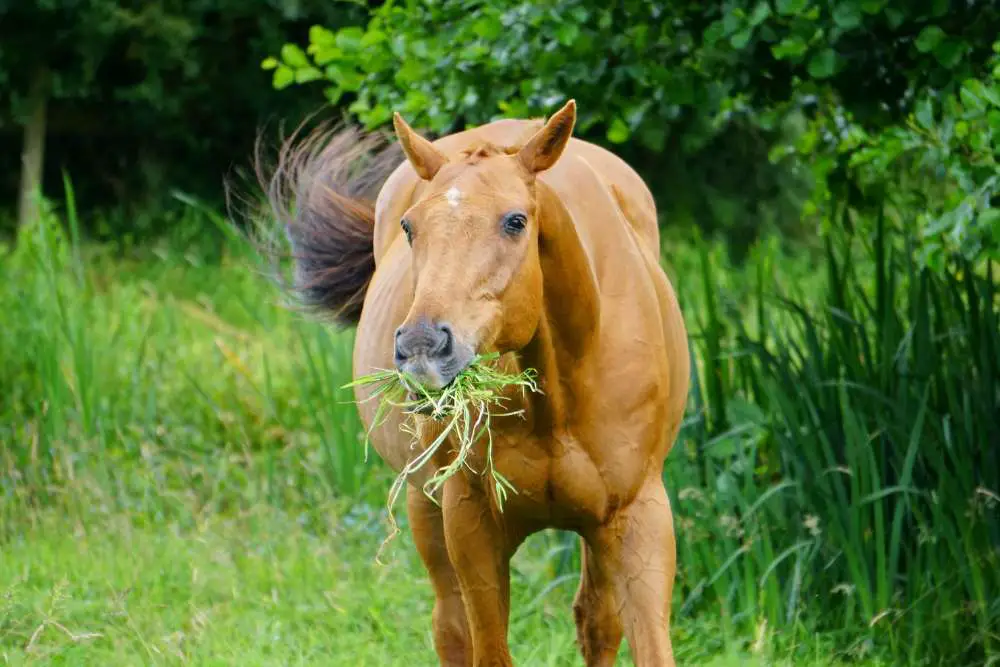
What Are Grass Glands in Horses?
Grass Glands or “Grass Mumps” are nicknames for the swelling of the Parotid Glands, which are the horse’s largest Salivary Glands.
The technical term for inflammation of the Parotid Salivary Glands is called Parotitis, or Parotiditis.
The Parotid Glands are located just below the ears and along the jawline area of the throatlatch, going down close to the jugular groove.
The glands themselves are a normal part of the horse’s body; however, swollen Parotid Glands are usually characterized by abnormally visible swelling behind the jaw area. When they have Grass Glands, some say their horse reminds them of a hamster.
Now to be clear the swelling also comes from the Parotid Lymph Nodes. These Lymph Nodes are a small, rounded structure that is embedded on the rostral side of the parotid salivary gland.
According to Michigan State University, rostral means toward the front of the brain or the top of the spinal cord, whereas caudal would mean toward the back of the brain or the bottom of the spinal cord.
Lymph Nodes are small structures that look like beans and are part of the horse’s immune system. Lymph Nodes filter substances that move through lymphatic fluid.
These substances include white blood cells (lymphocytes) that help the body fight off illness and infection. There are a lot of Lymph Nodes throughout the horse’s and your own body.
Now I want to point out Lymph Nodes can be considered glands, but not all glands are Lymph Nodes.
A gland, according to Google’s Oxford Languages, is “an organ in the human or animal body that secretes particular chemical substances for use in the body or discharge into the surroundings.”
For the sake of this article and simplifying, I may sometimes refer to swelling in the Parotid Glands instead of Lymph Nodes, since Nodes are sometimes referred to as glands.
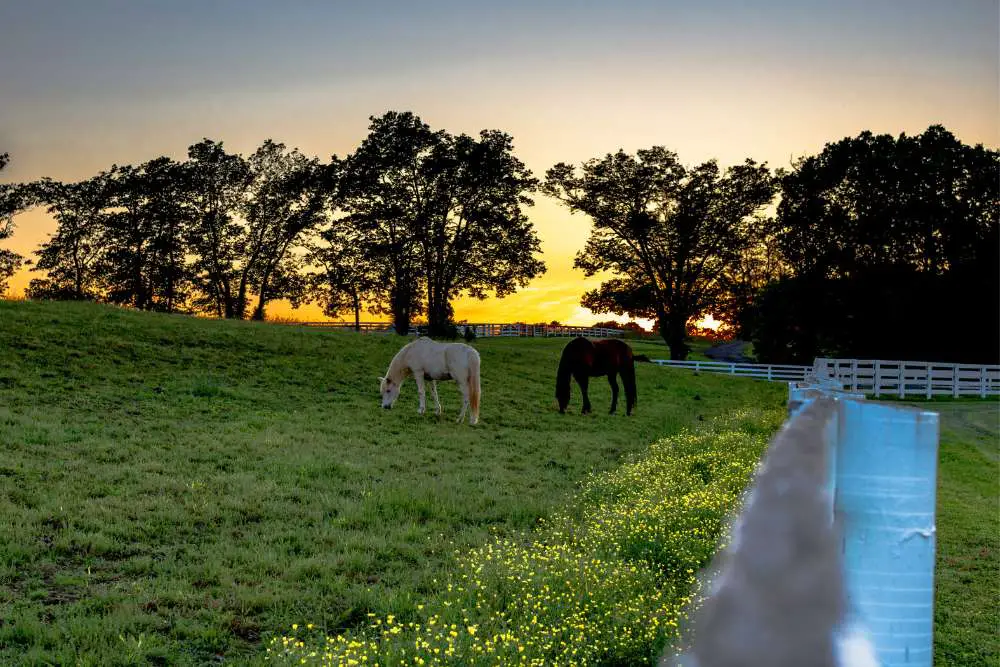
What Causes Horse Grass Glands?
Although these mumps rarely affect horses, they are thought to be an allergic reaction to certain types of grass, new grass, or pollen.
Lymph Nodes may swell because of the possible allergic reaction. Any allergen is a foreign substance in the body and therefore triggers an immune response.
This allergic response can in turn trigger the lymphatic system and lead to swollen Lymph Nodes.
It is thought that this is mostly caused by allergies to grass, since the swelling goes down when the horse is taken off the pasture.
Spring grass is another theory for the cause of inflammation in the Parotid Gland because it contains more sugars, and many horses do not appear to be affected by Grass Glands during other seasons of the year.
Another thought is that if they are eating a lot of grass or more grass than they are used to, their Salivary Glands are working harder, their body is not used to the excess grass, and it could be causing irritation.
However, Horse Grass Glands are still being studied, and not all causes of swelling are known. Other potential causes are dental issues, melanoma, lymph node reactions, and training practices.
Is it Dangerous for a Horse to Have Grass Glands?
No, if your horse does indeed have Grass Glands there is nothing to worry about. It is not dangerous, although the swelling may be uncomfortable. For some horses, it doesn’t seem to bother them at all.
When they’ve had enough time away from the pasture, any visible swelling should go away.
For the horse’s comfort, it’s important to figure out what’s wrong and take the right steps to make sure the horse’s symptoms go away and the swelling doesn’t come back.
In addition, it is important to distinguish Grass Glands from other swellings or abscesses on the horse’s face that could be more dangerous, such as Strangles.
Strangles is a serious bacterial infection that can spread quickly and cause painful swelling and other serious symptoms.
What is the Difference Between Grass Glands and Strangles?
Strangles is the swelling or abscessing of the Mandibular Lymph Nodes, whereas Grass Glands is the swelling of the Parotid Gland.
Strangles is caused by the bacterial infection Streptococcus equi, sometimes known as Strep. equi or S. Strangles is an upper-respiratory illness that is extremely infectious and most prevalent in young horses. It may quickly escalate, threatening the horse’s airway.
Other symptoms of Strangles include nasal discharge, fever, and abscesses, especially a swollen throat.
The best way to prevent Strangles is to decrease the risk of exposure and once again be as proactive as possible.
There are vaccinations available to help protect against Strangles.
Strangles are more likely to occur as the horse travels.
Because Strangles is a highly contagious disease, if you have been in contact with affected horses, you should wash all your clothes and shower before handling or even being around any other horses.
If you suspect your horse of Strangles immediately separate and quarantine them from the other horses. Disinfect everything you can, and of course, get a vet out there as soon as possible, as your horse needs treatment asap.
What Else Can Cause Swelling in the Horse’s Throat Area?
Swelling around the throat area and head is not always a sign of Horse Grass Glands.
Some other causes of swelling include:
- Strangles (which I just mentioned)
- Insect bites
- Bee or wasp stings
- Inflammation from an infected tooth
- Melanoma, which is common in grey horses
- Blockage in a Salivary Gland possible formation of a Salivary Stone
- Improper training
The best way to distinguish between all of these is to know your horse’s grazing schedule and if they have been on grass or not.
Call your vet if you want another opinion or if there are any other symptoms besides the swelling of the Parotid Glands.
Should You Take Your Horse Off the Pasture If They Have Grass Glands?
Horses with swollen Grass Glands may need time off the pasture, especially if there is no option to switch to a different pasture or type of grass.
More on this is in the “How to Treat Grass Glands in Horses” section.
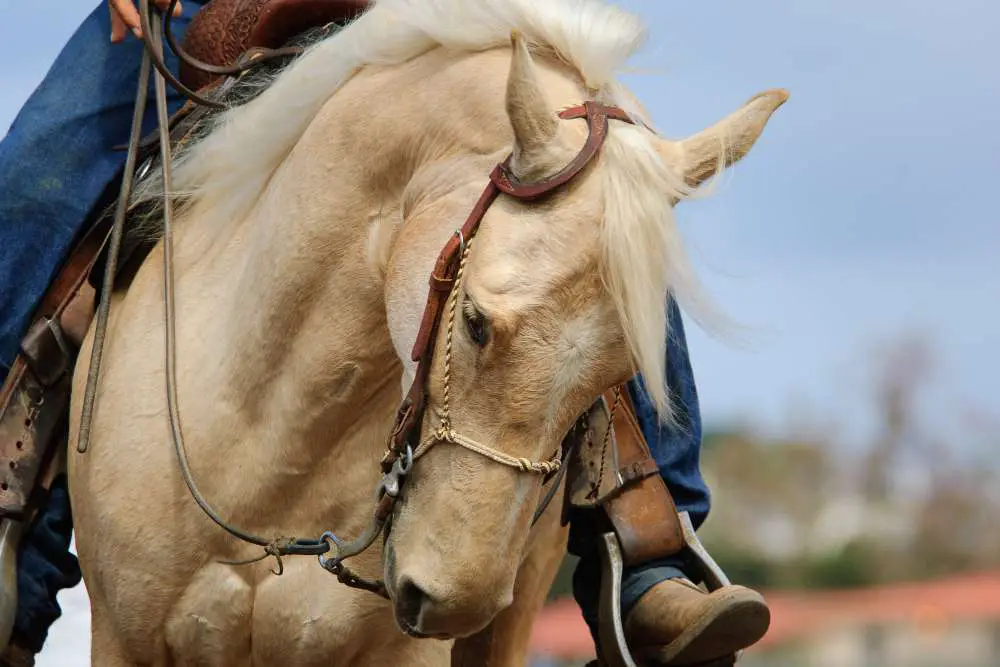
Can You Ride a Horse with Swollen Grass Glands?
A horse with a lot of swelling caused by Grass Glands will have difficulty riding in the correct outline, as the space in the throatlatch area will narrow.
Overflexion in the neck is even more of a problem when a horse has Grass Glands and actually causes the Parotid Glands to bulge even when the horse doesn’t have Grass Glands.
Overflexing your horse in regular training may overdevelop the Parotidoauricular Muscle, which covers the Parotid Glands.
This will cause compression of the Parotid Glands narrowing the area and causing them to bulge out more permanently, or until the horse has started to be worked correctly. A horse with proper training will have more space in this area and a cleaner throatlatch.
It is a good idea to lunge your horse in a halter for a few days until the swelling goes down.If you decide to ride your horse, let them stretch out long and low or hold their head in a comfortable position.
Another alternative is to work on your groundwork skills and polish up on the basics.
How to Treat Grass Glands in Horses
Because Horse Grass Glands are still being studied, there is currently no specific treatment for it. But at the moment, there are a few things you can do to help reduce the symptoms.
- This includes feeding your horse off the ground for a few days, whether throughout the day or when they come inside, to encourage any fluid buildup to drain.
- Moving them to a different pasture in case there is some plant or grass that they are allergic to that is only found in that paddock.
- Moving your horse to a dirt paddock that doesn’t have grass.
- If moving to a different turnout is not possible, keeping your horse inside and off grass for a couple days can help the issue, or you can try a grazing muzzle to see if it helps your horse.
- In general, like I said before, try to be less demanding in your exercise schedule and even switch to lunging in a halter while the swelling eases. Working your horse in a frame can cause discomfort because of the swelling. This will make your horse’s jaw tense, and it will be difficult for them to relax.
- Though more rare, your vet may decide to try treating your horse with an antihistamine.
Some herbal remedies to try:
- You can try feeding Dry Nettles, which are nutrient-rich and support skin problems and allergies.
- Chamomile can act as an anti-inflammatory as well as an anti-allergen.
- Devils Claw also acts as an anti-inflammatory.
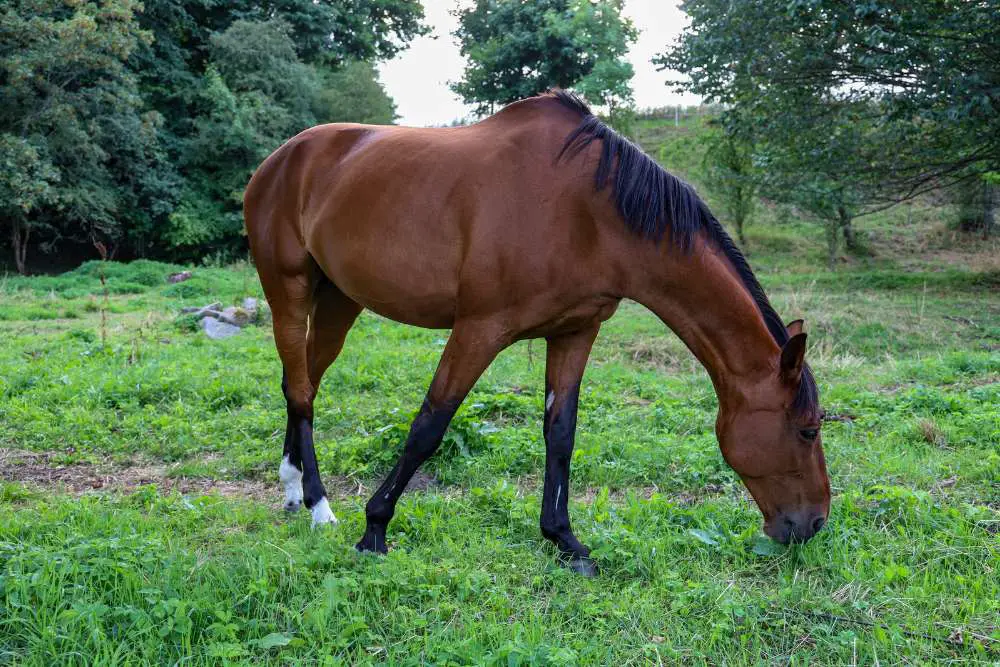
When to Call the Vet
It is always best to have a professional’s opinion on something you are not totally sure about whenever possible.
Many times you can get free advice by giving your vet a call. Although there may be times where the vet feels it is important for them to come check out your horse.
Also, try not to bombard your vet with calls all the time because they are very busy; call when there truly seems to be an issue.
When you notice swelling, be alert.
Here are some ideas for when to call the vet when your horse has swelling:
- You are worried, and it seems serious.
- If the swelling seems more like an abscess.
- If your horse has nasal discharge, even if it’s clear, combined with the swelling. Alone, a clear nasal discharge is usually not a problem.
- If your horse has a high temperature.
- If your horse appears to be having difficulty breathing.
- If your horse’s eating and drinking habits are abnormal.
- If your horse seems lethargic.
Your vet can determine what the cause is and what the appropriate treatment should be.
Ultimately, trust your gut and be as proactive as possible. And with horses as well as life, one of my sayings I stick with is “better safe than sorry.”
How to Prevent Grass Glands in Horses
The only way to prevent your horse from getting Grass Glands is to keep your horse from going out on grass.
You could try observing your horse in the different seasons to see if it is a seasonal issue. For example, maybe it only really occurs during the springtime.
Or observe your horse and see if a specific pasture is causing it.
You could try using a grazing muzzle and see if it helps prevent this problem.
Otherwise, turning out in a dirt paddock may be the best option.
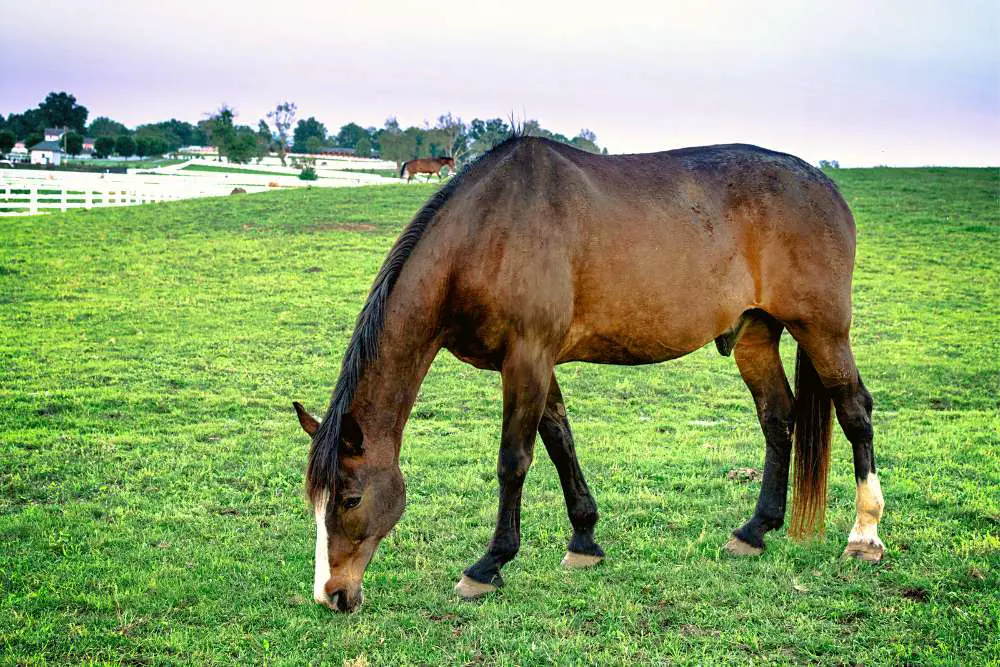
FAQs Related to Equine Grass Glands
Is all jaw swelling in horses caused by strangles?
Strangles typically causes swelling in the lymph nodes under the jawbone, while swelling behind the jaw and below the ears is more indicative of “grass glands.” So not all jaw swelling is necessarily caused by strangles. The location of the swelling provides clues as to whether it’s strangles or another condition.
Can new bailed grass hay cause grass glands?
The potential link between new bailed hay and grass gland reactions is still unclear. Since the cause of grass glands is thought to be an allergic response, it’s possible new hay could trigger swelling in some horses. But more research would be needed to confirm any relationship between freshly bailed hay and grass gland swelling.
What Other Lymph Nodes In My Horse’s Head Should I Watch Out For?
The mandibular lymph nodes, the retropharyngeal lymph nodes, and the parotid salivary glands are the ones to watch out for in the horse’s head.
What is the Difference Between Grass Sickness and Grass Glands?
Grass sickness, also known as Dysautonomia or Dysmotility, and is a serious digestive system condition that can easily turn life-threatening.
Symptoms of grass sickness include:
- Loss of appetite
- Weight loss
- Difficulty swallowing.
Grass sickness is caused by damage to the nerves that control the muscles in the digestive system.
Although the direct cause of the sickness is not fully understood, it is considered to be the result of the immune system’s reaction to a bacteria/parasite.
Treatment for grass sickness includes:
- Medications
- Nutritional supplements
- Changes in the equine’s diet
Although grass sickness can easily become life-threatening, Horse Grass Glands are a relatively harmless condition that usually goes away on its own.
Can Horses be Allergic to Grass?
Yes, horses can be allergic to grass (as well as plants and other substances).
Allergies are caused by an immune system reaction to a substance that is usually harmless.
Symptoms of allergic reactions include:
- Skin irritation
- Hives
- Swelling
- Coughing
- Sneezing
- Difficulty breathing.
Consult your veterinarian if you suspect that your horse may have allergies.
What Types of Grass Can Horses Eat?
Horses can eat a variety of grasses, including:
- Timothy
- Orchard
- Fescue
- Bluegrass
- Bermuda
- Alfalfa
Timothy grass is a common hay species and has a high fiber content.
Bluegrass is commonly found in pastures and has a higher protein content.
Bermuda grass is high in both fiber and protein content and is often found in warmer climates.
Some grasses that horses prefer the most include:
- Reed canarygras
- Perennial ryegrass
- Tall fescue
- Smooth bromegrass
- Meadow fescue
Are There Any Types of Grass Toxic to Horses?
Yes, there are certain types of grass that horses should not eat.
Some toxic grasses include:
- Sorghum
- Sudangrass
- Johnsongrass
- Any other varieties of these sorts
It is essential that all horse owners are aware of the type of grass their horses get turned out on and the toxic grasses in their area.
Can Horses Eat Grass Clippings?
No, horses cannot eat grass clippings.
Feeding lawn clippings will throw off the balance of microbes in your horse’s hindgut, which could cause them to colic or develop laminitis.
This is because grass clippings have a dangerously high amount of fermentable carbohydrates.
When too many grass clippings are eaten, there is a lot of fermentation that takes place in the hindgut.
What are Horse Grass Warts?
Horse Grass Warts are known as Papillomas or Fibropapillomas, which are benign tumors that can develop on the horse’s skin.
Horse grass warts, which are frequently caused by viral infection, are extremely contagious and spread through direct contact with infected horses or contaminated objects.
These warts are usually found as small, fleshy growths on the skin which are most often seen on the face, neck, and chest.)
Grass Warts are typically benign and do not cause discomfort. However, they can become big and may cause difficulty with sight or your horse’s ability to eat, especially if they develop on the face or neck.
Warts can be removed with surgical removal or cryotherapy (freezing), but some cases may resolve on their own.
Just like all issues with horses, it is best to be proactive by practicing good hygiene, such as not sharing grooming equipment between horses.
When It Comes To Horse Grass Glands
Although swelling from Horse Grass Glands can be concerning and unsightly, most of the time, it is relatively harmless if it is not accompanied by any other symptoms.
A horse can look bright, alert, and happy even with Grass Mumps.
Everything simply depends on the situation, so always look at the big picture, and when in doubt, call your veterinarian to help you reach a clearer conclusion.
Cheers, Kacey Cleary

